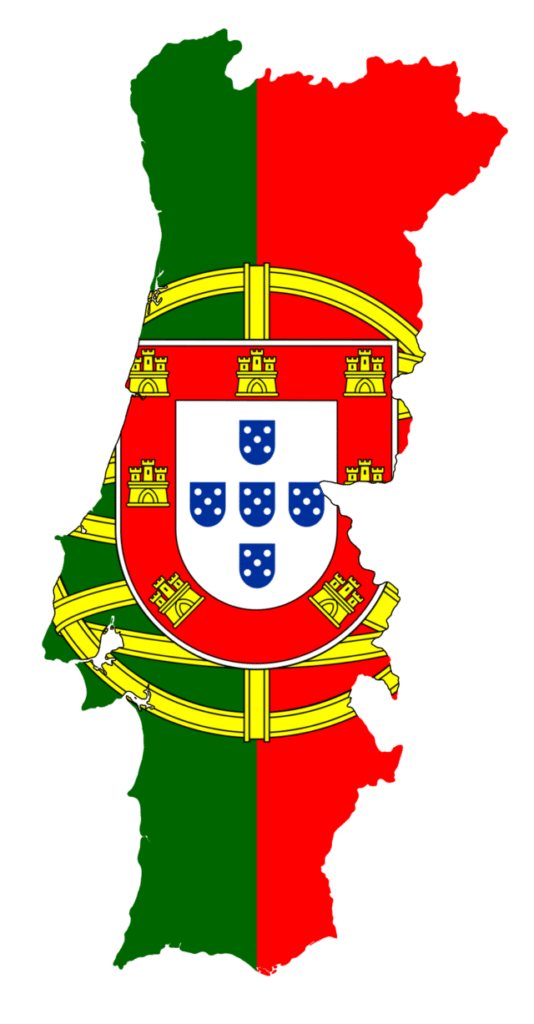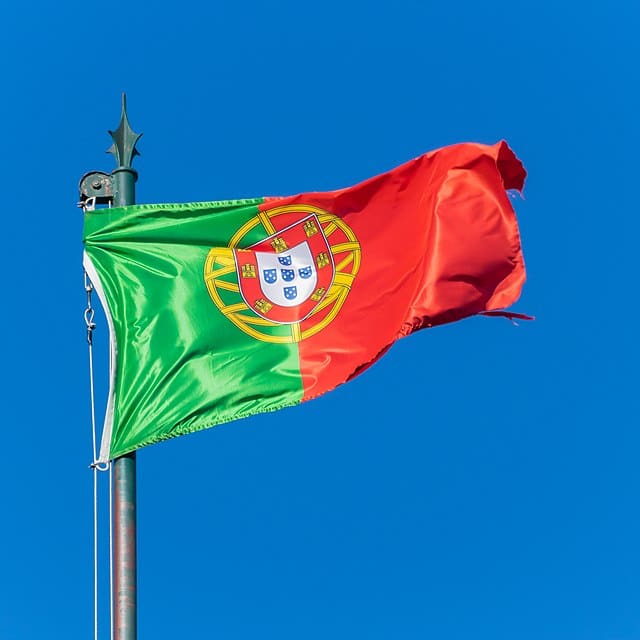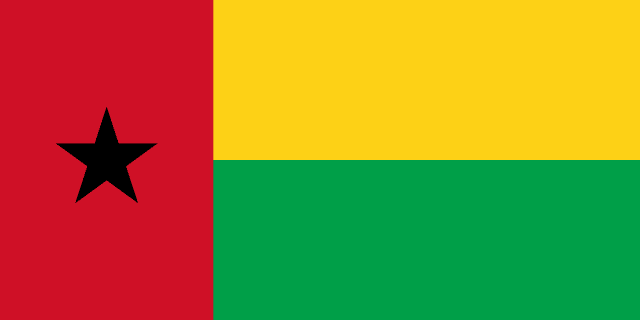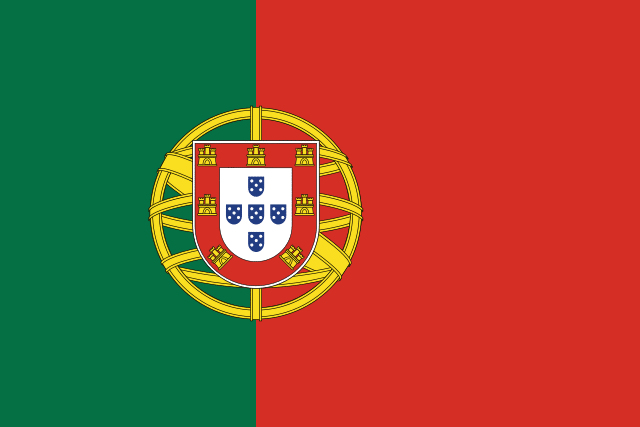Contents
Portugal captivates tourists with its fascinating past, beautiful scenery, and dynamic culture. The Portugal flag, a representation of the country’s history and character, sits at the center of this alluring land. The flag is famous for its significant historical importance beyond its striking colors and elaborate design.
In this article, we will dig into the profound significance of the flag’s vivid colors and discuss the historical occurrences and milestones that influenced its development.
Portugal: Country Profile
The Portugal flag is a perfect representation of the country’s profile. Portugal is a place that promises life-changing experiences, whether you indulge in the regional cuisine, immerse yourself in centuries-old customs, or simply take in the breathtaking surroundings. That’s why we believe that understanding the history behind the flag requires a brief knowledge of the country’s profile.
Geography & Location
Portugal, which is tucked away on the western tip of the Iberian Peninsula, is an intriguing nation with varied and beautiful scenery. The country has a gorgeous 1,200-kilometer (746-mile) coastline that is bordered by Spain to the east and the wide Atlantic Ocean to the west. Portugal’s topography offers an incredible fusion of natural beauty and cultural richness, from the rolling hills of the Douro Valley to the craggy cliffs of the Algarve.
Portugal observes Western European Time during most seasons, which is UTC+0. Just like most other EU countries, during warmer months the time in Portugal switches to daylight saving time, which is UTC+1, Western European Summer Time.

Demography
With a population of around 10.3 million, Portugal is a tiny nation with a tight-knit society. The bulk of people live in coastal regions and big cities like the capital, Lisbon, and Porto. The national language is Portuguese, and the nation has a rich cultural legacy influenced by many other cultures, including Christian, Moorish, and Celtic customs.
History
Portugal has had a significant impact on world history, from the Roman Empire through the age of discovery and colonialism. Portuguese explorers like Vasco da Gama and Ferdinand Magellan set out on ambitious expeditions throughout the 15th and 16th centuries, finding new sea routes and developing commercial networks that linked Europe to Africa, Asia, and the Americas.
Culture
The history, customs, and creative manifestations of Portugal are profoundly ingrained in the country’s culture. A national treasure that captures the yearning and passion of the Portuguese spirit is the melancholy and soulful form of music known as fado. The nation is also known for its exquisite azulejo tiles, which are used to embellish ancient structures with elaborate designs and brilliant colors. The famed pastéis de nata (custard tarts) and renowned port wine made in the Douro Valley are just two of Portugal’s gastronomic treasures.
Visitors come to Portugal from all over the world because of its friendly hospitality and laid-back attitude. It is home to breathtaking UNESCO World Heritage Sites, including the Porto Old Town, Sintra’s Cultural Landscape, and the Douro Valley’s Vineyards. Additionally, the nation is home to magnificent natural parks like Peneda-Gerês and Serra da Estrela, which give outdoor enthusiasts the chance to go hiking, mountain biking, and exploring a variety of habitats.
Portugal has a vibrant football culture that produces world-class players and hosts important athletic occasions. The Carnival of Torres Vedras and the Festival of So Joo in Porto, when the streets come alive with music, dance, and boisterous festivities, are only two of its well-known vivid events.
Design & Symbolism of Portugal Flag
The Bandeira de Portugal has a tricolor rectangle shape with three vertical stripes of red, green, and green that are all the same width from left to right. The green bars on either side are just a little wider than the red band in the center.
The Portugal flag’s vivid colors have deep symbolic meaning. Both the country’s lush scenery and the deep green bands serve as symbols of optimism. The striking red ribbon represents the Portuguese people’s historical fortitude, bravery, and tenacity. These hues, when combined, inspire a sense of solidarity and pride in one’s country.
Symbolism
The Portuguese flag is a complex tapestry of symbolism that symbolizes the history of the country. The color red is reminiscent of the Age of Discoveries when Portuguese explorers set out on risky journeys throughout the world and forever changed the course of human history. Additionally, it honors the suffering and sacrifices endured during Portugal’s wars for independence and supremacy.
The green ribbons represent the nation of Portugal’s goals and hope, as well as its close ties to the natural world. Portugal’s lush surroundings, which include the attractive vineyards, undulating hills, and fertile farmland that dot the nation, are sometimes linked with the color green.
The Portugal flag has a 2:3 aspect ratio, which means that it is 1.5 times longer than it is taller. The red band in the middle of the flag is somewhat broader than the green bands on each side. The breadth of the flag is split into three equal vertical bands.

Similarities With Guinea-Bissau Flag
Surprisingly, the flag of Guinea-Bissau, a nation in West Africa, is somewhat similar to that of Portugal. The tricolor of green, red, and yellow is present in the flag of Guinea-Bissau, although the red band has a black star in the middle instead of green. Given that Guinea-Bissau was originally a Portuguese colony, this likeness might be linked to the historical links between Portugal and its former colonies.

History of Portugal Flag
Origins and Early Flags
The history of the Portugal flag begins in the 12th century, during the reign of Afonso Henriques, the country’s first king. It was called the “Cross of the Order of Christ” and was the country’s first national flag. The intimate relations between Portugal and the military order that was instrumental in the Reconquista, the Christian reconquest of the Iberian Peninsula, were represented by this flag, which had a white cross on a blue backdrop.
The Burgundy Cross
The Portuguese flag experienced a substantial modification under King Joao I‘s rule in the 14th century. The Battle of Aljubarrota in 1385 resulted in a significant victory over the Kingdom of Castile. King Joo I made the Burgundy Cross the national flag in honor of this victory. The cross was made up of four pointed crimson arms that crossed a white area.
The Modern Portugal Flag’s Origins
The modern Portugal flag, as we know it now, first appeared in the early 20th century. The monarchy was overthrown on June 19, 1911, and the Portuguese Republic was subsequently established. The new administration demanded a flag that embodied both the aspirations of the populace and the republic’s founding values.
The First Portuguese Republic’s flag was a straightforward tricolor with green, red, and a dark blue shade that was in use from 1911 until 1919. Later, in order to more accurately reflect the spirit of the country, the blue band was altered to a rich shade of red.
The Current Portugal flag
The flag of Portugal underwent another change in 1919. The flag thereafter took on its current appearance: a tricolor with two vertical bands of green on the outside margins and a broader red band in the middle. Plus, the dark blue band was swapped out for a deep red tone. This modification was made to the flag to better match the hues of the Portuguese Coat of Arms.

Flag Days & National Observances
The Portuguese flag is honored on several national holidays and flag days because of its significance. One such event is Portugal Day, which is observed annually on June 10 and honors the late national poet Luís de Camões. The flag is proudly flown on this day around the nation, promoting nationalism and solidarity.
Influence on Former Colonies
Portugal flag has had an impact on the flags of its former colonies as a former colonial power. Several nations, like Mozambique, Angola, and Guinea-Bissau, have flags that resemble Portugal’s tricolor pattern, sometimes combining it with special emblems that stand for their respective national identities.
Portugal Flag Protocol
Portugal adheres to a flag protocol that specifies the right handling, display, and use of the flag in order to maintain adequate respect and reverence for this emblem. Here are some essential rules:
- The Portugal flag should be flown from dawn to sunset, preferably on a flagpole. It should keep a prominent position when flown with other flags and be placed on the right. The flag is swiftly raised and ceremoniously lowered during formal events and ceremonies.
- The Portugal flag may be flown at half-staff to signify sadness or to commemorate a national catastrophe. The flag should be hoisted to the top of the flagpole before being gradually lowered to the midpoint.
- The Portugal flag should be handled with respect. Never should it touch the ground or be used for any usage that would take away from its honor.
- Flag etiquette states that during the playing of “A Portuguesa,” the national anthem, everyone should stand at attention with their right hands over their hearts and face the flag.
Bottom Line
The Portugal flag is a steadfast symbol of the history and resilience of the country. It is a remarkable emblem that captures Portugal’s history and soul thanks to its vivid colors, minute details, and powerful symbolism. This article has illuminated the extraordinary narrative behind the flag’s design and the ideals it stands for — unity, independence, and integrity.